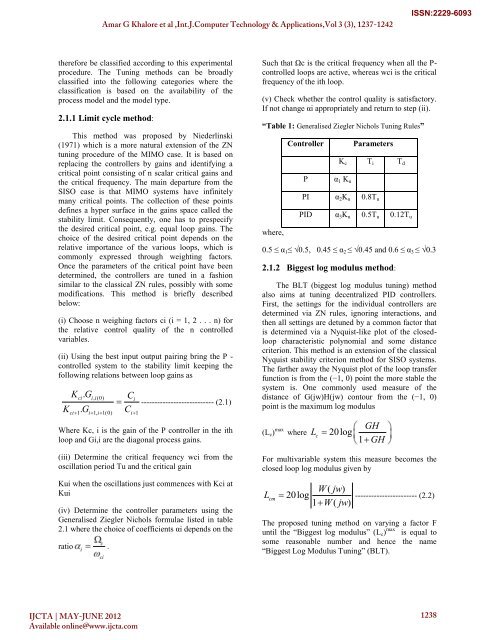Relay Approach for tuning of PID controller - International Journal of ...
Relay Approach for tuning of PID controller - International Journal of ...
Relay Approach for tuning of PID controller - International Journal of ...
You also want an ePaper? Increase the reach of your titles
YUMPU automatically turns print PDFs into web optimized ePapers that Google loves.
Amar G Khalore et al ,Int.J.Computer Technology & Applications,Vol 3 (3), 1237-1242<br />
ISSN:2229-6093<br />
there<strong>for</strong>e be classified according to this experimental<br />
procedure. The Tuning methods can be broadly<br />
classified into the following categories where the<br />
classification is based on the availability <strong>of</strong> the<br />
process model and the model type.<br />
2.1.1 Limit cycle method:<br />
This method was proposed by Niederlinski<br />
(1971) which is a more natural extension <strong>of</strong> the ZN<br />
<strong>tuning</strong> procedure <strong>of</strong> the MIMO case. It is based on<br />
replacing the <strong>controller</strong>s by gains and identifying a<br />
critical point consisting <strong>of</strong> n scalar critical gains and<br />
the critical frequency. The main departure from the<br />
SISO case is that MIMO systems have infinitely<br />
many critical points. The collection <strong>of</strong> these points<br />
defines a hyper surface in the gains space called the<br />
stability limit. Consequently, one has to prespecify<br />
the desired critical point, e.g. equal loop gains. The<br />
choice <strong>of</strong> the desired critical point depends on the<br />
relative importance <strong>of</strong> the various loops, which is<br />
commonly expressed through weighting factors.<br />
Once the parameters <strong>of</strong> the critical point have been<br />
determined, the <strong>controller</strong>s are tuned in a fashion<br />
similar to the classical ZN rules, possibly with some<br />
modifications. This method is briefly described<br />
below:<br />
(i) Choose n weighing factors ci (i = 1, 2 . . . n) <strong>for</strong><br />
the relative control quality <strong>of</strong> the n controlled<br />
variables.<br />
(ii) Using the best input output pairing bring the P -<br />
controlled system to the stability limit keeping the<br />
following relations between loop gains as<br />
K . G C<br />
K . G C<br />
ci i, i(0)<br />
i<br />
ci 1 i 1, i 1(0) i 1<br />
--------------------------- (2.1)<br />
Where Kc, i is the gain <strong>of</strong> the P <strong>controller</strong> in the ith<br />
loop and Gi,i are the diagonal process gains.<br />
(iii) Determine the critical frequency wci from the<br />
oscillation period Tu and the critical gain<br />
Kui when the oscillations just commences with Kci at<br />
Kui<br />
(iv) Determine the <strong>controller</strong> parameters using the<br />
Generalised Ziegler Nichols <strong>for</strong>mulae listed in table<br />
2.1 where the choice <strong>of</strong> coefficients αi depends on the<br />
ratio<br />
i<br />
c<br />
ci<br />
.<br />
Such that Ωc is the critical frequency when all the P-<br />
controlled loops are active, whereas wci is the critical<br />
frequency <strong>of</strong> the ith loop.<br />
(v) Check whether the control quality is satisfactory.<br />
If not change αi appropriately and return to step (ii).<br />
“Table 1: Generalised Ziegler Nichols Tuning Rules”<br />
where,<br />
Controller<br />
P<br />
Parameters<br />
K c T i T d<br />
α 1 K u<br />
PI α 2 K u 0.8T u<br />
<strong>PID</strong> α 3 K u 0.5T u 0.12T u<br />
0.5 ≤ α 1 ≤ √0.5, 0.45 ≤ α 2 ≤ √0.45 and 0.6 ≤ α 3 ≤ √0.3<br />
2.1.2 Biggest log modulus method:<br />
The BLT (biggest log modulus <strong>tuning</strong>) method<br />
also aims at <strong>tuning</strong> decentralized <strong>PID</strong> <strong>controller</strong>s.<br />
First, the settings <strong>for</strong> the individual <strong>controller</strong>s are<br />
determined via ZN rules, ignoring interactions, and<br />
then all settings are detuned by a common factor that<br />
is determined via a Nyquist-like plot <strong>of</strong> the closedloop<br />
characteristic polynomial and some distance<br />
criterion. This method is an extension <strong>of</strong> the classical<br />
Nyquist stability criterion method <strong>for</strong> SISO systems.<br />
The farther away the Nyquist plot <strong>of</strong> the loop transfer<br />
function is from the (−1, 0) point the more stable the<br />
system is. One commonly used measure <strong>of</strong> the<br />
distance <strong>of</strong> G(jw)H(jw) contour from the (−1, 0)<br />
point is the maximum log modulus<br />
GH<br />
(L c ) max where Lc<br />
20log 1 GH<br />
For multivariable system this measure becomes the<br />
closed loop log modulus given by<br />
L<br />
cm<br />
W ( jw)<br />
20log 1 W ( jw )<br />
----------------------- (2.2)<br />
The proposed <strong>tuning</strong> method on varying a factor F<br />
until the “Biggest log modulus” (L c ) max is equal to<br />
some reasonable number and hence the name<br />
“Biggest Log Modulus Tuning” (BLT).<br />
IJCTA | MAY-JUNE 2012<br />
Available online@www.ijcta.com<br />
1238
















